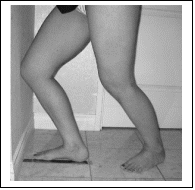Put Away the Goniometer for The Ankle!
Clinically, ankle dorsi-flexion (DF) is the most commonly lost motion following ankle injuries.
Functionally it will effect activities such as gait, stair climbing, running and squatting.
Restricted ankle DF may be a significant factor for recurring ankle sprains, persistent plantar fasciitis and Achilles Tendinitis.
I have personally found little value in the Goniometric method of measuring ankle dorsi-flexion ROM. I have also found little value in ?eye-balling? ROM of the ankle, as restrictions can not often be seen.
An excellent, reliable, quick and easy method of measuring ankle DF is using the ?knee to wall? method. No fancy equipment required! ?just a wall and a ruler.
Technique:
Start with the tip of the big toe a certain distance (…lets just say 10 cm) from the wall. Then ask the patient to take the knee directly forwards (staying over the middle toe) until the knee touches the wall. If the knee touches the wall, move the foot back 1-2 cm and repeat again. Determine how far the foot can be away from the wall and still have the knee touch? WITHOUT a compensatory heel lift occurring.
Compare the two sides. If both ankles are symmetrical?(i.e. both 8cm or both 15cm from the wall) that is considered normal.
If the unaffected ankle/foot is 12cm and the symptomatic ankle/foot is 5cm from the wall?that may be considered significant and it should certainly be addressed with mobilizations.
Research on asymptomatic individuals, shows no significant difference in ankle DF ROM between sides, but significant variations among individuals.
Conclusion: Ankle DF ROM should not be compared with reference ranges, but with the opposite foot.
Posted on: February 21, 2002
Categories:


